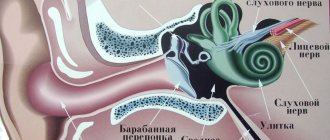Types of organic dementia
Types of organic dementia are determined by the time of occurrence of the disorder and the degree of its impact on mental processes. The disease is usually classified as residual or progressive. The first is more typical for children, the second for older people.
Residual organic dementia is essentially a residual lesion formed as a result of the impact on the brain of other factors that destroy it: infections, injuries, toxic poisoning. Finding itself defenseless against these problems, the brain begins to deteriorate, but while the root cause is eliminated, the consequences persist forever. They cannot be corrected, but they do not worsen unless other reasons contribute to this. This type of dementia is characterized by dementia and psychopathic-like behavior.
A progressive organic disorder develops slowly, affecting more and more areas of the brain. It is this type that includes the classic version of senile dementia, when mental functions fade away gradually, along with motor functions. It should be noted that, unlike residual, which can stop at one stage of development, progressive will develop constantly until it ultimately leads to the death of the patient.
Methods for diagnosing organic dementia
Diagnosing the initial stages of the disease is quite difficult. To do this, it is necessary to use techniques that are not used during preventive examinations. A more or less complete picture can be obtained if you use during diagnosis:
- Special testing showing the current level of cognitive and mental functions.
- X-ray.
- Computed tomography.
- Encephalography.
The final diagnosis is made after examination by at least three specialists: a therapist, a neurologist and a psychiatrist, since there is a high probability of developing other diseases that also affect the patient’s psyche.
Diagnostics
The diagnosis of vascular dementia in older and younger people is established on the basis of anamnesis, the presence of characteristic symptoms in the patient and the results of various studies.
To determine the disease that caused the development of dementia, the patient is referred for examination to various specialists (neurologist, cardiologist, psychiatrist, etc.).
Blood pressure is also monitored, since hypertension is one of the most common factors in the development of vascular dementia. Localization of brain lesions in various types of dementia
| Localization of the lesion | Relevant diagnoses |
| Cerebral cortex |
|
| Subcortical zone |
|
| Cortical-subcortical |
|
Computed tomography of the head, Doppler ultrasound of cerebral vessels, electrocardiography, as well as MRI for vascular dementia will help determine the presence, nature and localization of pathologies that led to the onset of dementia.
Literature
- Gavrilova S.I. Mental disorders in primary degenerative (atrophic) processes of the brain. // Guide to Psychiatry / Ed. A. S. Tiganova. M., 1999. T. 2.
- Medvedev A.V. Vascular diseases of the brain // Guide to psychiatry / Ed. A. S. Tiganova. M., 1999. T. 2.
- Korsakova N.K., Moskovichiute L.I. Clinical neuropsychology. M., 2003 (Chapter 5 “Neuropsychological syndromes in aging”).
- Clinical Psychiatry / Ed. T. B. Dmitrieva. - M.: GEOTAR-Medicine, 1998
- Gavrilova, S. I.
Modern ideas about Alzheimer's disease: [arch. August 6, 2017] / Scientific and Methodological Center for the Study of Alzheimer's Disease and Associated Disorders of the Scientific Center for Clinical Prevention of the Russian Academy of Medical Sciences, Moscow. - Snezhnevsky, A.V.
Lecture 7: Hypochondriacal, affective syndromes. Dementia syndromes: [arch. June 7, 2012] // General psychopathology: Course of lectures. — Medpress-inform. — ISBN 978-5-00030-214-9. - Perfilyeva G. M.
Alzheimer's disease: problems of patient care: [arch. September 4, 2007] / Prof. G. M. Perfilyeva.
Types of Dementia
Scientists identify about 10 types of dementia. The classification is based on the causes of dementia.
| Kinds | Description |
| Senile dementia | AGE CHANGES Localization: cortex and subcortex |
| Vascular | VASCULAR IMPAIRMENT, INFLAMMATION Localization: unsystematic destruction |
| Dementia in Parkinson's disease | FORMATION OF PROTEIN “PLAQUES” Place: death of neurons in subcortical formations |
| Multiple sclerosis | THE MYELIN SHEATH IS DESTROYED Locally: diffuse myelination |
| Schizophrenic dementia | ON THE BACKGROUND OF MENTAL DISORDER Without localization |
| Toxic encephalopathy | DEGENERATION DUE TO TOXIC FACTORS |
| Traumatic dementia | ENCEPHALOPATHY AND NEURON DEATH AS A RESULT OF CHRONIC TRAUMATIZATION Cells are diffusely affected |
Senile and vascular dementia
Senile. The disease begins at the age of 65-70 years. As a rule, the symptoms of the disease are similar to Alzheimer's disease. The progression of symptoms is slow. Drug therapy can briefly control the first manifestations of dementia. Among other things, dementia is often accompanied by severe physical illnesses (hypertension, diabetes, lung disease or oncology).
Vascular. There is an acute and chronic form. The first type is associated with a vascular accident (stroke, heart attack, rupture of a cerebral aneurysm). This dementia is the second leading cause of dementia. Men suffer first of all. Vascular risk factors: smoking, high cholesterol, high blood pressure, diabetes. Psychiatry is accompanied by signs of neurological diseases (decreased reflexes, gait disturbance, aphasia).
Dementia in Parkinson's disease and multiple sclerosis
Parkinson. Dementia is characteristic of the later stages of the disease. It takes 10-15 years from the first symptoms. Typical slowness and apathy are accompanied by complete indifference and forgetfulness. Rarely manifests as hallucinations and delusions
Memory, attention, orientation in time and space are more often reduced
Executive dysfunction is characteristic (the patient cannot carry out simple instructions). Dementia makes Parkinson's disease more severe: with it, falls occur more often, and gait disturbances progress.
It is detected already in the early stages of the disease. Patients tend to be slow. For example, simple tasks take twice as long. At the height of the disease, patients quickly become exhausted. Even at the onset of the disease, short-term memory is reduced. Severe disorders develop in the secondary progressive form.
Schizophrenic and toxic dementia
Schizophrenia. Characterized by transient dementia. In other words, a patient with profound dementia may show intact intelligence and memory during remission. Symptoms of perceptual disorder predominate. For example, the patient does not consider the world to be real. Or does not perceive himself as a person. Thinking is disrupted. Thoughts are not lined up. The patient speaks grammatically correct but meaningless sentences. There are never memory disorders.
Toxic dementia. Occurs when consuming ethyl alcohol, narcotic or poisonous drugs. The alcoholic form is more common in men 45-50 years old. Meanwhile, drug-induced dementia is typical for young people and adolescents. Thinking, speech, memory changes. Outbursts of aggression and antisocial behavior are typical. In the early stages, patients show infantility. Pathology leads to severe mental disability.
Traumatic, idiopathic and epileptic forms
Traumatic. Occurs in professional athletes and soldiers. First of all, frequent mood swings are characteristic. For example, aggression and thoughts of suicide appear. The patient has difficulty planning and organizing. Parkinsonian symptoms may occur. The first signs of the disease appear at a young age. However, dementia appears after 50.
Idiopathic. It is called Fahr syndrome. Characterized by calcium accumulation in the basal ganglia. The age of onset of symptoms is 30-50 years. The clinical picture of parkinsonism is growing. Later chorea and dystonia appear. The result is dementia, psychosis and delirium in later stages.
Epileptic. Develops with an unfavorable course of the disease (frequent seizures, falls). The character changes from helpful to aggressive. Patients are dependent on the opinions of strangers. As a result, memory sharply decreases. For example, the patient is unable to remember simple information. There is a tendency to reasoning (using many useless words). Typically, dementia is mild to moderate.
Clinical and psychological characteristics of dementia and dementive disorders
Dementia
(F00-F03) is a persistent decrease in cognitive activity and loss of already acquired knowledge and skills. Its consequences are largely determined by the age of the patient and the reasons that caused brain dysfunction. Quantitative losses of certain mental functions, as well as the qualitative specificity of concomitant disorders that arise within the framework of dementia, their coloring are directly related to the degree of development of the functional apparatuses of the brain involved in the pathological process, with the level at which they are realized. Dementia is a diagnosis made in the case of brain pathology that occurs only after the age of three.
Systematics and classification of organic dementia presents significant difficulties. This is due to the fact that there are many factors that lead to a complex clinical and psychological structure of mental disorders. Classification is carried out according to the following criteria:
– criterion for the dynamics of the disease process
: residual and progressive dementia;
– etiological
criterion: epileptic, postencephalic, traumatic, rheumatoid, etc.
– criterion for the specificity of the clinical-psychological structure
, or leading pathopsychological syndrome.
According to the first criterion, dementia is classified into two main types: residual
(residual) and
progressive.
Residual dementia is the result of a single pathological effect of harmfulness on the brain: pathological changes in the brain have already led to changes in mental functions, to their collapse, but further decay of functions no longer occurs.
Dementia in this case is the residual result of brain damage. Progressive dementia
is observed in cases of ongoing pathological effects of hazards on the brain during an ongoing organic process. Harmfulness can be endogenous, genetically determined, or may be a consequence of exogenous harm. Progressive dementia is a consequence of such clinical conditions as chronic inflammatory diseases of the brain (meningitis, encephalitis), progressive tumor process of brain tissue, severe forms of epilepsy, schizophrenia, sclerosis of brain tissue, various degenerative diseases of the nervous system. In all these cases, there is constant destruction of the nervous tissue of the brain, and the consequence of this is the collapse of mental functions. The decay of mental functions will also be progressive, up to the complete collapse of the psyche.
Mental disorders due to previous inflammatory diseases of the brain (meningitis and meningoencephalitis).
Inflammatory diseases of the brain are caused by infectious agents - pathogenic bacteria and viruses, which, settling in the tissues of the membranes or in the substance of the brain, cause an inflammatory disease. Inflammation manifests itself in tissue damage, swelling in the area of inflammation and cell proliferation, which leads to the appearance of scars on the tissue. In other words, as a result of inflammatory diseases, a defect occurs in the substance of the brain and its membranes, which initially disrupts the normal mental and personal development of the child.
In organic dementia due to meningitis and meningoencephalitis, there is a pronounced disturbance in the neurodynamics of mental processes, disturbances in the purposefulness of activity and a pronounced disturbance in criticality. In these cases, three main types of dementia may occur: 1) organic dementia with gross impairment of mental operations; 2) delayed mental development with a violation of the prerequisites for the development of intelligence (memory, attention); 3) psychopathic behavior with a gross violation of the emotional-volitional sphere.
With epidemic encephalitis, the intellect suffers only in more severe cases, more often when the disease begins at an early age. But even with relatively intact intelligence, children cannot study at school; their activity and initiative are sharply reduced. Attention is especially affected: its stability, ability to switch and distribute are reduced. With intact intelligence, attention is drawn to the discrepancy between the ability to comprehend and the lack of a critical attitude towards oneself and the environment, the contrast between sufficiently developed judgment and grossly impaired behavior. The sharp depletion of intellectual activity and emotional impoverishment are also striking; patients give the impression of people who are indifferent to everything, uninterested in anything. However, they often have outbursts of irritability and impulsiveness.
Psychopathic-like disorders are also often observed in the form of psychomotor disinhibition, tactlessness, irritability, rudeness, pathological desires (theft, arson, wanderlust, gluttony, alcohol abuse), and decreased criticism of oneself even with formally intact intelligence. Disturbances in the emotional sphere are also expressed in the existence of various fears and obsessive states, for example, fear of infection, getting sick, obsessive counting, obsessive movements, etc.
Senile (senile) dementia. Senile dementia most often develops in older people aged 65–85 years, although it can develop earlier or later. The disease almost always begins slowly, unnoticeably, but there are characterological changes that resemble personality changes that are characteristic of natural aging, but differ from them in severity, rapid progression and exaggeration. At the initial stage, there is a sharpening of individual psychological characteristics, but later this is smoothed out. Personal pathological changes typical of senile dementia (senile psychopathization of personality) occur.
Prevalence. Senile dementia is considered a common form of psychopathology in late life. About 5–10% of people over 65 years of age suffer from senile dementia. At a later age, the risk of developing the disease increases. Among patients with senile dementia, the number of women is twice as high as the number of men. The prognosis of senile dementia is extremely unfavorable due to the inevitable occurrence of profound dementia, marasmus and death of patients within 8–10 years from the onset of the first symptoms of dementia. The prognosis will be somewhat better for late onset dementia (after 80–85 years), when the rate of increase in dementia is slower.
Reasons for the development of the disease. Gerontopsychiatrists place senile dementia in the category of endogenous-organic mental diseases, considering it as an expression of pathological aging of the brain and the body as a whole. A large role in the development of the disease is assigned to the hereditary factor. It has been proven that the risk of senile dementia in relatives of patients is significantly higher than in others. is a common cause of dementia in old age .
This is a progressive disease characterized by a gradually increasing decline in a person’s mental functions with impaired ability to understand the environment and loss of skills. Alzheimer's disease can begin after age 50, but most often occurs after age 70 and especially after age 80. Less commonly, dementia is based on the development of other diseases characteristic of late age. These include Pick's disease, Parkinson's disease and some other rare diseases.
The anatomical basis of the disease is diffuse atrophy of the cerebral cortex and accompanying morphological changes. A pathological examination revealed a decrease in brain weight to 1000 g or less, the gyri become thinner, and the sulci and ventricles of the brain expand due to internal hydrocephalus. Microscopic studies show that the number of nerve cells is greatly reduced. Morphological changes in neurons are often detected in macro- and microscopic studies of the brains of people who died in old age and did not suffer from senile dementia. But for them these changes are not so pronounced and regular.
Symptoms. Patients become similar in character, they are characterized by caricatured egocentrism, they are callous, stingy, and collect old unnecessary things. Such people lose their former interests and hobbies, but at the same time there is a disinhibition of basic biological needs: the appetite increases immoderately, hypersexuality manifests itself in the form of an inflated interest in young people of the opposite sex, the person is inclined to talk about eroticism, and sometimes there are attempts at depraved acts with teenagers.
The mental life of such patients becomes primitive and monotonous, they are often gloomy and irritated. Already at the beginning of the disease, symptoms of mnestic and intellectual deficiency arise, which over time reach the stage of deep dementia, when all mental activity collapses. First, mechanical memory suffers, then fixation amnesia develops, which leads to disorientation in time and place. Much later, the orientation in one’s personality is upset, which sometimes comes to the point of not recognizing one’s reflection in the mirror. In the future, the development of memory disorders occurs according to the pattern of progressive amnesia. Memory loses its reserves, from recently acquired skills and knowledge to older and automated ones. Gradually, the memory becomes empty: patients do not know where they live, whether they have children, or their age or profession. Often, gaps in memory are filled with false memories.
Thinking disorders, which begin with difficulties in generalizing and establishing a cause-and-effect relationship, are constantly growing and lead to a misunderstanding of simple issues and the inability to comprehend the surrounding situation. Speech remains orderly for quite a long time, but subsequently becomes rudely upset, turning into talkativeness. Perception becomes blurry and indistinct.
Some patients experience a “shift into the past”; they do not remember at all the last years, decades and most of their lives, but they have memories of distant youth, youth, which they regard as what is happening around them. Patients insist that they are 20 years old, that they just got married and have small children. The furnishings of the hospital room are mistaken for the previous apartment, and in those around them they recognize deceased relatives and old friends. Patients often sleep for a long time during the day, and at night suffer from insomnia, which is accompanied by fussiness and walking. At night, episodes of false orientation and confusion occur, attempts to leave, and packing things “for the road” occur.
The behavior of patients at the beginning of dementia is relatively orderly, but over time they become more and more fussy and confused, helpless in everyday affairs, incapable of self-care and sloppy. Patients leave home and are unable to find their way back, turn on the gas in their homes, and commit arson. Senile dementia occurs in waves or continuously progressively. Some patients can live to the stage of insanity, when they are practically motionless, indifferent, inaccessible to communication, lying in a fetal position, only certain biological needs are preserved.
The development of dementia in old age is most often gradual. An exception is some forms of vascular dementia, which usually develop after a stroke. The first manifestation of the disease is memory impairment for current events. The ability to memorize decreases, the assimilation of new things is incomplete and unstable. A person becomes distracted, current events in his experiences are replaced by the revival of memories of the past. As a rule, orientation in time worsens, and the idea of the temporal sequence of events is disrupted. Memory disorders are almost always accompanied by changes in a person’s character. Previously inherent personal characteristics are erased. He becomes rude, selfish, traits of rigidity and unreasonable stubbornness, outbursts of excitement and anger appear. In other cases, apathy and inactivity come to the fore. A person becomes passive, indifferent to everything, lethargic, inactive. In some patients, personality changes are characterized by the appearance of special mental fragility, weakness, exhaustion, and lack of restraint.
As dementia progresses, symptoms of dementia become apparent. Orientation is disrupted, first in time, then in space and the surrounding environment. Patients cannot name the date, month and year, often get lost on the street, do not always understand where they are, and do not recognize friends and loved ones. In advanced cases, orientation in one’s own personality is also disturbed. Patients cannot tell their age and forget key facts of life. Thinking is becoming increasingly impoverished. The stock of knowledge accumulated in life is gradually lost. The patients' memories become more and more incomplete, confused, and inaccurate. Memory errors are often replaced by fictitious events. Speech is impaired and vocabulary is significantly depleted. Gradually, speech increasingly loses its meaning; in severe cases, the statements of patients take on the character of stereotypical phrases, fragmentary words and syllables. Habitual skills are impaired: patients lose the ability to use household appliances, cannot dress or wash themselves. Conscious actions are replaced by stereotypical wandering and senseless collecting of things. The ability to count and write is impaired. With severe dementia, a person loses the ability to exist without outside help, his activity is limited to meaningless screams and stereotypical movements within the bed.
Impaired memory and higher mental functions in dementia are accompanied by behavioral disorders. These patients are often agitated and have unmotivated stubbornness, which makes care much more difficult. Patients refuse to perform necessary hygiene procedures and eat food. In some cases, on the contrary, there is an increased appetite. Sometimes during periods of excitement, patients tear their underwear, break things, and become aggressive. Often, patients with dementia also experience other mental disorders: absurd delusional statements, false perceptions, prolonged depression.
Treatment and prevention. Patients with senile dementia, first of all, need observation and care. They need to provide dietary nutrition, and also need to ensure that physiological functions are regular and the skin is clean, achieve physical activity and, if possible, involve the patient in simple forms of activity. The behavior of patients must be kept under constant control, as they commit dangerous acts.
While effective therapy for senile dementia has not yet been developed, this process cannot be stopped.
Classifications of acquired dementia
In medical practice, there are several classifications based on the causes of the disease, severity or localization of the pathological process. However, the generally accepted and most complete clinical classification is considered to be one that takes into account several factors simultaneously.
Classification of the disease according to the anatomical location of the lesion in the central nervous system:
- cortical – degenerative lesions are located within the cerebral cortex;
- subcortical – damage to structures located under the cortex (basal ganglia, hypothalamus, limbic system and other anatomical formations);
- cortical-subcortical – simultaneous involvement of the cerebral cortex and subcortical structures in the pathological process;
- multifocal - multiple foci with dead nerve cells are randomly located in all parts of the brain.
Classification of dementia by etiology (cause of occurrence) includes two forms:
- primary – the cause is direct damage to the brain and the development of irreversible changes in it;
- secondary – death of nerve cells as a consequence of other diseases (arterial hypertension, HIV infection) or the result of exposure to toxic substances on the brain.
The most common in medical practice is a classification that simultaneously takes into account the cause of the disease and the characteristics of clinical manifestations. It allows you to develop the correct treatment tactics and assess the prognosis of the disease. Clinical forms of dementia are represented by the following types:
- dementia due to Alzheimer's disease;
- dementive syndrome caused by other common lesions of the nervous system (Parkinson's, Pick's, Creutzfeldt-Jakob and Huntington's diseases);
- acquired dementia of vascular origin;
- other types of dementia (HIV dementia syndrome, alcoholism dementia);
- mixed form (simultaneous combination of several varieties).
Based on the severity of symptoms of dementia, there are three forms of the disease: mild, moderate and severe. This classification takes into account the degree of impairment of higher brain functions (speech, abstract thinking, memorizing information, ability to work and learn) and their impact on the quality of life.
A mild form of dementive syndrome is characterized by significant mood swings and excessive emotionality, mild cognitive and mental changes in memory, attention and intelligence. Patients' social adaptability is slightly reduced, but the ability for light work, self-care and independent living is retained.
Moderate dementia occurs with severe impairments of memory and intelligence. A person is able to satisfy his basic physiological needs (food, drink, going to the toilet), but becomes helpless in solving everyday affairs and household concerns.
Severe dementia leads to complete disability. Persons with severe forms of the disease require constant care due to the inability to meet even the physiological needs of the body.
Levels of dementia by severity have not only medical significance, but also legal significance. Persons with a severe type of dementive syndrome are declared legally incompetent. They are unable to exercise their civil rights and need a guardian.
Content
- 1 Classification
- 2 Diseases that may be accompanied by dementia 2.1 Infections
- 2.2 Deficit states
- 2.3 Metabolic disorders
- 5.1 Main classification of late-life dementia
- 7.1 Alzheimer's disease
Causes
It is impossible to say unequivocally what was the cause of the development of the disease: there are many factors that have a negative impact on the nervous and vascular systems, which lead to senile dementia.
Most doctors are of this opinion: the disease affects those people who experience general aging of the circulatory and neuropsychological systems.
It is impossible to talk about a hereditary background one hundred percent, but it may turn out to be the decisive link that tips the scales on the side of pathology.
The following factors can cause senile dementia:
- Vascular changes in the brain, that is, atherosclerosis - the formation of so-called cholesterol plaques on the walls of blood vessels, leading to increased permeability, deterioration of nutritional functions and blood supply to the organ.
- Necrosis of brain tissue due to a stroke is hemorrhage in a certain area, which subsequently undergoes destructive changes.
- Infectious diseases that damage areas of the brain.
- Receiving head injuries, which causes a rupture between neural connections, which are subsequently replaced by connective tissue.
- A growing tumor causes compression of certain areas in which malfunctions occur or their complete exclusion from activity.
The causes of senile dementia can be various concomitant diseases that cause gradual depression or destruction of vital body systems.
Diabetes mellitus, chronic alcoholism, immunodeficiency virus - have a detrimental effect on all organs, primarily on blood vessels and nerves.
The underlying causes of the development of senile dementia is inhibition of brain functions.
This can happen due to one factor or several: in the latter case they speak of a mixed type.
Main manifestations
Are memory impairments in old age a manifestation of an incipient illness, dementia? The answer is not simple. The development of pathological changes in the brain in degenerative diseases is several years ahead of the first manifestations. Dementia affects all components of human existence, not just cognitive function. It causes changes in behavior, personality disorder, and disturbances in daily activities. Early-stage symptoms may include frequent or prolonged mood swings (mostly sadness, depression), changes in personality traits, unusual reactions in normal situations, or sudden “blackouts” in activities that have not occurred before. Self-focus often increases and respect for others is lost.
Sometimes the first manifestations of dementia in an elderly person are increased sensitivity, a sense of danger, delusions of persecution, and hallucinations. Memory impairments may occur later and are not necessarily the first sign of illness.
It is important that if you notice some of the changes and problems described, the person, accompanied by a relative or other close person, visits a doctor, preferably one who specializes in memory disorders. This could be a specialist from the field of psychiatry, psychology, neurology or geriatrics
A clinical psychologist may also conduct specialized testing of cognitive function. If symptoms indicate true cognitive impairment or dementia praecox, your doctor may perform or refer you for additional diagnostic tests that may indicate the cause of the disorder and, as a result, begin treatment.
Symptoms
The clinical picture is manifested by disturbances in memory, attention, thinking, personality, emotions and behavior.
There are two groups of symptoms:
- Required. These are the ones needed to make a diagnosis of dementia. These include hypomnesia, fixation amnesia, increased distractibility and absent-mindedness, decreased abstract thinking, predominance of concrete situational thinking, optical-spatial disorders and disorder of higher cortical functions (arithmetic counting, reading, understanding and speech formation).
- Additional symptoms that indicate dementia, but are not necessary for the diagnosis. These include personality changes, emotional-volitional disorders, behavioral disorders, psychotic episodes (hallucinations, delusions), and disturbed sleep. Additional symptoms also include neurological signs: disturbance of gait, coordination, and appropriateness of movements.
Treatment and prevention
Senile dementia is an irreversible, progressive disease that cannot be completely cured. Therefore, treatment is a set of measures aimed at maintaining the required standard of living, as well as slowing down the progression of the disease to a more severe stage.
The following treatment methods are used:
- Medication. Treatment of senile dementia is mainly symptomatic or preventive. Nootropics are prescribed that enhance mental activity, memory, and antipsychotics that help stabilize the emotional background. An important role is given to drugs that affect the condition of blood vessels, anticoagulants.
- Sociotherapy and psychotherapy. Includes assistance from specialists from various industries who will help in adapting to the new state and will talk about the psychological, social and even legal side of the issue. At the meetings, relatives will be told what to do during an outburst of aggression in the patient, whether the patient should be allowed to be alone, whether a will is valid for senile dementia or not, and many other questions.
The feasibility of prevention has long been controversial, causing much disagreement among scientists and doctors around the world. But recently it is believed that prevention is necessary, as it helps prevent the occurrence of diseases that most often cause or accompany dementia.
For prevention, the following are important:
- moderate mental activity;
- proper nutrition, including vitamins and microelements in sufficient quantities;
- exclusion of trans fats;
- moderate physical activity;
- adherence to daily routine;
- maximum exclusion of depression and any negative emotions;
- giving up bad habits (smoking, alcohol).
It is very important to take care of the cardiovascular system, monitor blood pressure and cholesterol levels in the blood. Life expectancy with proper care is almost not reduced, except in cases with complications or severe concomitant diseases
In this case, the following pattern is most often revealed: the later the symptoms of senile dementia in older people begin to appear, the milder the disease progresses, and vice versa
Life expectancy with proper care is almost not reduced, except in cases with complications or severe concomitant diseases. In this case, the following pattern is most often revealed: the later the symptoms of senile dementia in older people begin to appear, the easier the disease progresses, and vice versa.
Research Facts
One 2013 study from the Nizam Institute of Medical Sciences in India found that speaking two languages may delay the development of dementia. An analysis of medical records of 648 cases of dementia found that those who spoke two languages developed dementia an average of 4.5 years later than those who spoke only one language[5].
Recently, studies have appeared indicating a slight decrease in the percentage of people suffering from dementia in the total number of elderly people in developed countries. So, if in 2000 in the United States 11.6 percent of people over 65 had dementia, then in 2012 there were much fewer of them: 8.8 percent[6].
There are 16 scientific studies demonstrating the effect of phosphatidylserine on reducing symptoms of dementia or cognitive impairment[7]. In May 2003, the US Food and Drug Administration (FDA) approved a Qualified Health Claim for phosphatidylserine, allowing US manufacturers to state on their labels that “Consumption of phosphatidylserine may reduce the risk of dementia and cognitive impairment in older adults.” However, this statement must for now be accompanied by the caveat that “very limited and preliminary scientific research suggests that phosphatidylserine may reduce the risk of cognitive dysfunction in older adults,” since the Agency considered that the scientific community is still divided on this topic, and the majority studies were done using phosphatidylserine derived from cow brain rather than the soy phosphatidylserine that is currently used[7].
The most common form of dementia
Among the causes leading to the development of dementia, Alzheimer's disease ranks first. The first mention of it dates back to 1906, and its discoverer is considered to be the German psychiatrist Alois Alzheimer.
The disease begins to manifest itself at the age of 55–70 years. This is one of the forms of senile insanity and refers to the atrophic type of dementia, when the destruction of brain neurons occurs. There may be several reasons contributing to this disease: internal diseases, obesity, low intellectual and physical activity, diabetes. A special place is given to the hereditary factor.
The disease begins to manifest itself with a violation of short-term memory. First, the patient forgets events that happened to him recently, and then those that happened a long time ago. A person does not recognize his children, mistaking them for deceased loved ones. He has difficulty remembering what he did a few hours ago, but talks in detail about what happened to him as a child. At this stage of the disease, the patient develops egocentrism and delusional ideas. Speech, perception, and motor disorders are observed.
The next stage is characterized by emotional disruptions. The person becomes irritable, grumpy, and shows dissatisfaction for any reason. He claims that his relatives want to get rid of him in order to take possession of his property, and his neighbors and friends want to slander him in order to spoil his reputation.
Intelligence decreases sharply: analytical functions suffer, reasoning becomes poor. Interests are narrowed, the opportunity to perform professional skills is lost.
Such people need care and supervision. Behavior disorder is manifested by vagrancy, uncontrollability in eating and sexual intercourse. Aimless actions appear, speech contains constant repetition of one word or phrase, and replacement of words with new ones. But, despite extensive degenerative changes, self-criticism remains.
At the final stage, the patient loses cognitive functions, the ability to care for himself, does not understand what they want from him, self-control and criticality are lost. Motor restrictions, paralysis, pathological reflexes, and convulsive seizures occur. The patient assumes the fetal position, refuses to eat, and cachexia progresses.
The disease lasts on average 10 years. But the earlier it manifests itself, the faster and more severe it progresses.
Unfortunately, at the moment there is no treatment that could stop the progression of the disease and return the patient to his former life. But early signs in menopausal women can be stopped with hormonal therapy.
Scientists have found that Alzheimer's in the early stages can be recognized by the nature of laughter. The fact is that in this case a person gradually loses control and does not understand what to laugh at and where it is inappropriate. He increasingly turns to black humor, laughs at absolutely unfunny, offensive, and sometimes tragic events, and at the failures of other people. Thus, one patient laughed at his wife when she was scalded by boiling water.
It is believed that a change in the sense of humor is an important criterion in establishing a diagnosis, since its diagnosis is, in principle, difficult.
Alzheimer's disease is a very common disorder. For example, Peter Falk, better known as Lieutenant Colombo, was also smitten by him. After he found out about this, he immediately stopped all his filming. Lately, the actor has completely forgotten about the existence of Columbo and wonders why people on the street call him by that name.
Stages
Progressive dementia develops in stages. At each stage new symptoms appear:
- Preclinical stage. Characterized by subtle signs of intellectual disorders. Symptoms are often explained as a result of lack of sleep, fatigue, hunger, or burnout.
- The soft stage is characterized by primary impairments of memory and attention. At this stage, the patient compensates for the intellectual defect by writing down thoughts in a notebook. A person at the soft stage can perform work duties, since professional skills have not yet been impaired.
- Moderate. Characterized by disturbances in memory, thinking, and attention. The opportunity to work is lost. Partial assistance from outsiders is required in household chores, for example, in preparing food or calculating utilities.
- Heavy. It is manifested by the disintegration of the personality core, and complete social and hygienic incapacity is observed. Patients are completely dependent on the help of people, since they cannot work, eat, or go to the toilet on their own. Severe dementia is also characterized by apathy and abulia, a decline in speech, thinking and memory.
Definition and classification
Dementia is a disorder of brain function characterized by loss of acquired knowledge and skills. The process is irreversible.
In most cases, this disease is diagnosed in older people. At this age, the disease is much more complex and has obvious symptoms.
There are three large groups of dementia.
- Atrophic type or Alzheimer's - primary destructive processes are observed in the nervous system (about 50% of all cases).
- Cerebrovascular - the condition is a secondary disease that develops against the background of serious abnormalities in blood circulation in the brain (5 - 10% of all cases).
- Mixed type, which is characterized by both mechanisms of disease development (from 15 to 20% of all cases).
Based on where the organic defect is localized, the following types of dementia are distinguished:
- cortical - the cerebral hemispheres are affected;
- subcortical - the subcortical region of the brain is affected;
- cortical-subcortical - mixed pathology of the first two types;
- multifocal - there are multiple lesions in different parts of the nervous system.
From a clinical point of view, there are:
- lacunar dementia, in which, first of all, the structures responsible for intellectual activity are affected, especially short-term memory is damaged;
- total - there is an absolute disintegration of the personality, the intellectual sphere and emotional-volitional activity are disrupted, a person’s spiritual values and vital interests disappear, and absolute disadaptation appears in society.
Notes
- Disease ontology database (English) - 2021.
- ↑ 123
Monarch Disease Ontology release 2018-06-29sonu - 2018-06-29 - 2018. - Over 46 Million People Now Have Dementia Worldwide, Time (25 August 2015). Retrieved August 26, 2015.
- ↑ 1 2 WHO.
WHO fact sheet.
Dementia (undefined)
.
WHO website
(December 1, 2017). - International Alzheimer's Disease Report 2009 (unspecified)
. Access date: June 18, 2021. - “In an apartment with a monster: illness turns old people into monsters” “Moskovsky Komsomolets” No. 27345 dated March 15, 2021.
- ↑ 1 2 Rhett S. Thomson, Priscilla Auduong, Alexander T. Miller, Richard K. Gurgel.
Hearing loss as a risk factor for dementia: A systematic review // Laryngoscope Investigative Otolaryngology. — 2017-03-16. - T. 2, issue. 2. - pp. 69-79. — ISSN 2378-8038. - doi:10.1002/lio2.65. - Suvarna Alladi, Thomas H. Bak, Vasanta Duggirala, Bapiraju Surampudi, Mekala Shailaja, Anuj Kumar Shukla, Jaydip Ray Chaudhuri, Subhash Kaul.
Bilingualism delays age at onset of dementia, independent of education and immigration status (English) // Neurology : journal. — 2013. — Vol. 81, no. 22. - P. 1938-1944. — ISSN 0028-3878. - doi:10.1212/01.wnl.0000436620.33155.a4. - Kenneth M. Langa, Eric B. Larson, Eileen M. Crimmins et al.
A Comparison of the Prevalence of Dementia in the United States in 2000 and 2012 // JAMA Internal Medicine (English) Russian. : journal. — 2021. — Vol. 177, no. 1. - P. 51. - ISSN 2168-6106. - doi:10.1001/jamainternmed.2016.6807. - ↑ 12
Phosphatidylserine and Cognitive Dysfunction and Dementia (Qualified Health Claim: Final Decision Letter)
Prevention of dementia
Prevention of dementia in young and middle age includes replenishing the deficiency of B vitamins, as well as folic acid, increasing intellectual and physical activity.
Prevention of dementia to relieve symptoms such as irritability, impulsivity, and depression is carried out through sea therapy. The condition of the nervous system improves thanks to bromine contained in sea air. Sea air relaxes, removes fuss and irritability. It is advisable to carry out prevention from middle age. As practice shows, the percentage of patients is high among those who did not lead an active, mobile lifestyle.
Signs of dementia in Alzheimer's disease
More than 35 million people worldwide suffer from Alzheimer's disease or other forms of dementia in old age. The incidence is estimated to double every 20 years.
The main symptom of an organic disorder is memory loss. First of all, the cells of a person’s short-term memory center die off; he cannot remember what he has been doing lately, who he was talking to, etc.
Other consequences of the disease include impairment of rational thinking (correct judgment and assessment of the situation) and spatio-temporal perception - the patient may suddenly wander in places that he previously knew closely, or lose the sense of time (a sense of a timeless state), location.
Frequent changes in emotional level and mood are also typical for the disease - alternating euphoria, depression, apathy. A person suffering from Alzheimer's disease may lose inhibitions and therefore break social conventions (inappropriate behavior, selfishness, anger). Often these people lie for no reason.
Due to the destruction of centers and connections in the brain, the disease can affect the ability to move properly and coordinate actions, so patients may have problems maintaining balance, walking, and some routine tasks become very difficult for them.
Dementia is a serious problem today - living standards are rising, average age is increasing, resulting in an increasing number of patients. The big problem is that doctors and specialists cannot cure dementia - in some clinical stages of the disease (mild to moderate severity), the symptoms and rate of progression of the disorder may only slow down, but there is no cure.
Memory loss affecting the ability to perform normal tasks
It is normal to occasionally forget work assignments, co-worker names, or phone numbers in “waves” (with subsequent recall). But people with Alzheimer's disease are more likely to forget, not remembering later. Diagnosis of dementia begins with memory testing.
Problems performing routine activities
Very busy people often get distracted, so sometimes they forget about the milk boiling in a saucepan on the stove. But the amnesia of people with Alzheimer's disease is of a different nature - they prepare food and not only forget to put it on the table, but also do not remember that they made it.
Problems with expression
While a healthy person rarely has problems finding the right word, a patient with Alzheimer's disease forgets simple words or replaces them with incorrect words, as a result of which his speech does not make sense.
Temporary and local disorientation
Everyone sometimes forgets what day it is. This is fine. But people with Alzheimer's disease get lost on familiar streets, don't know where they are, how they got there, or how to find their way home. Travel and air travel become impossible for such people.
Poor or deteriorating rational judgment
Sometimes people get so involved in an activity that they momentarily forget about the child they are looking after. Patients with Alzheimer's completely forget that the child exists. They may even dress inappropriately, such as wearing multiple items in the same category (eg shirts or blouses).
Problems with abstract thinking
Calculating utility bills can take a long time if they are more complex than usual. The problem comes when a person completely forgets what the numbers mean and what to do with them.
Putting things in the wrong places
Do you sometimes put your wallet or keys in an unusual place? Not scary. A person with dementia puts things in completely meaningless places: an iron in the refrigerator or a watch in the sugar bowl.
Changes in mood or behavior
A bad mood is an eternal companion of modern people. A patient with Alzheimer's is subject to sudden mood swings. Suddenly and unexpectedly he bursts out, cries, succumbs to anger for no apparent reason.
Personality changes
A person's personality usually changes to some extent as they age. But a patient with dementia can change fundamentally. Sometimes he becomes very confused, suspicious, or fearful (signs similar to those of PTSD).
Losing initiative
Reluctance to do housework or social responsibilities. Does this description sound like you? Do not worry. Usually activity at work returns soon. But with dementia, a person can become completely passive and need constant incentives to take initiative.
Dementia - what is this disease?
Dementia is insanity, expressed in the breakdown of mental functions, which occurs due to brain damage. The disease must be differentiated from oligophrenia - congenital or acquired infantile dementia, which is a mental underdevelopment.
With dementia, patients are not capable of realizing what is happening to them; the disease literally “erases” everything from their memory that accumulated in it during the previous years of life.
Dementia syndrome manifests itself in many ways. These are disorders of speech, logic, memory, and causeless depressive states. People suffering from dementia are forced to leave work because they require constant treatment and supervision. The disease changes the life of not only the patient, but also his loved ones.
Depending on the degree of the disease, its symptoms and the patient’s reaction are expressed differently:
- With mild dementia, he is critical of his condition and is able to take care of himself.
- With a moderate degree of damage, there is a decrease in intelligence and difficulties in everyday behavior.
- Severe dementia – what is it? The syndrome means a complete breakdown of personality, when an adult cannot even relieve himself or eat on his own.
Behavior Change: Comparison Chart
Dementia develops slowly, with symptoms increasing gradually, so it is necessary to pay attention to even minimal signs. On the other hand, not all age-related changes are signs of dementia: as we age, many of us lose the ability to make sound judgments, become irritable or forgetful
To make the difference clearer, here is a comparison table of age-related changes and changes caused by dementia.
| Sometimes names or upcoming events are forgotten | Loss of memory for current events interferes with daily functioning |
| Decreased vision and hearing | Problems of understanding what is seen or heard, spatial relationships |
| Periodic inability to remember a specific word or phrase: “It’s on the tip of your tongue.” | Constant problems of word usage both in speech and in writing |
| Forgetfulness at times, such as not being able to remember where your glasses or keys are | Constant loss of things, inability to restore the chain of actions to find them |
| Difficulty learning new things, such as using objects such as a microwave or computer | Inability to solve everyday household problems |
| They confuse events and dates; for example, they may remember what exactly happened, but be mistaken about the time or place | Unable to name the current date, day of the week, or location |
| They may make mistakes when filling out forms, invoices, etc. | Difficulty with planning, problem solving, etc. |
| From time to time they begin to find communication with friends and relatives and maintaining social contacts tiresome | Gradually withdraw from work and any social activity |
| Get irritated when routine is disrupted | Personality, character, mood completely changes |
| They make mistakes and make bad decisions | Impaired judgment leads to negative consequences |











